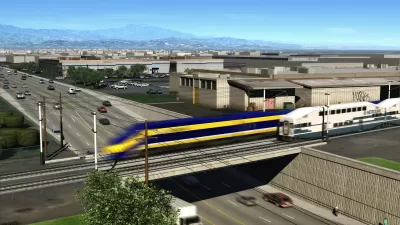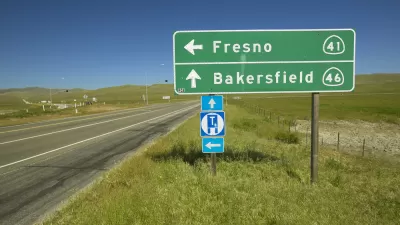The state has less than one-third the funds necessary to build the 800-mile line connecting Northern and Southern California, depending on the cost estimate. The immediate goal is to build a 119-mile section in the Central Valley.

"The high-speed train in California, championed by [Gov. Jerry] Brown, a Democrat, and Arnold Schwarzenegger, his Republican predecessor, is the most ambitious public transportation project underway in the nation today," reports Adam Nagourney, Los Angeles bureau chief of The New York Times. Unlike the privately funded, 240-mile Houston to Dallas Texas Central high-speed rail line, the California High-Speed Rail Authority has not attracted private financing.
"Beginning construction without all of the financing in place represents a strategic gamble by the rail authority, and by Mr. Brown, that once enough work is completed, future leaders will be loath to walk away from the project and leave a landscape of unfinished pillars, viaducts, bridges and track beds," adds Nagourney.
Faced with reduced resources, the authority has altered its plans, and is now focused on finishing a 119-mile stretch of track from Bakersfield to Madera by 2022. [See California High-Speed Rail Authority project sections Merced to Fresno and Fresno to Bakersfield].
One problem with that plan is that the state's two main population centers see no evidence of high-speed rail construction, with the possible exception of newly constructed poles along the San Francisco peninsula, financed in part with $600 million from the rail authority, used to electrify the San Francisco-to-San Jose commuter rail line, Caltrain. The regional project is scheduled for completion in 2023, and high-speed rail, traveling along the same corridor, 11 years later.
Backing the Central Valley plan is Brian P. Kelley, who was the first secretary of the California State Transportation Agency (CalSTA), and as of Jan. 17, the Authority's new chief executive officer. With one section operating, "people will rally around the project and the business community would become convinced of its viability," adds Nagourney.
“If I can get trains on the ground, Californians will start to see that this is something that we want,” said Kelly.
“Yes, the project has challenges,” Mr. Kelly said. “And the primary challenge for this same project is the same today as it was the day the voters passed the bond: And that is, we don’t have enough money to build what we want to build.”
"As of now, the rail authority has come up with less than $30 billion of the necessary $100 billion, and the project’s costs are expected to continue to rise," adds Nagourney.
“The rest has to be found,” said Martin Wachs, an emeritus engineering professor at the University of California at Berkeley and a member of a committee appointed by the Legislature to review the project. “At the moment, 100 percent of the cost is going to be absorbed by the taxpayers.”
Cost estimates
On March 12, Adam Brinklow, associated editor of CurbedSF, reported that the Authority's "new draft plan estimates a cost of more than $77 billion (up from the previous overrun estimate of $64 billion) and cautions that the whole thing could get even pricier down the line."
Costs are uncertain and construction could end up either cheaper or more costly than expected, but more costly is likely: The plan sticks to the previously reported low-end estimate of $63.2 billion for the LA-SF corridor but also provides a high-end projection of $98 billion. $77.3 billion is the present “base” estimate. [Also see Tim Sheehan's ariticle in The Fresno Bee on the draft plan's cost estimates.]
Aside from tapping some of the $9.95 billion funding from Proposition 1A, High-Speed Rail Act (2008), the state began providing cap-and-trade auction proceeds to the project, including committing 25 percent of all future revenues annually, according to the Legislative Analyst's Office. As of January 8, 2016, $5 billion of the bond funds had been appropriated, in addition to $3.5 billion in federal funding received under the Obama administration.
Political uncertainty after Brown retires this year
"For all the construction, the project faces the ever-present threat that a future governor may decide that state resources would be better used dealing with, to name one example, the housing crisis," adds Nagourney.
Mr. Brown’s enthusiastic backing has been crucial to the project’s advances. Gavin Newsom, the Democratic lieutenant governor and the leading contender to succeed Mr. Brown, has offered conflicting views of the project over the years; he has at times come close to opposing it outright...By contrast, his Republican opponent, John Cox, has pledged unequivocally to abandon the project if elected.
While the public is split on support for the project, according to a U.S.C./Dornslife/Los Angeles Times poll done in May, support drops considerably when told of cost overruns.
Nagourney goes on to describe more challenges awaiting the project, not the least of which is "tunneling through the Tehachapi Mountains, a barrier between the Central Valley and Los Angeles...which Mr. Kelly said could cost anywhere from $4 billion to $13 billion."
Will the 119-mile "build it now" strategy work?
"The more they can show what they have done, the harder it is to abandon the project,” Mr. Wachs said, but adds that the next governor, at some point, might say, "Let’s not throw more good money after bad.’”
FULL STORY: A $100 Billion Train: The Future of California or a Boondoggle?

Alabama: Trump Terminates Settlements for Black Communities Harmed By Raw Sewage
Trump deemed the landmark civil rights agreement “illegal DEI and environmental justice policy.”

Planetizen Federal Action Tracker
A weekly monitor of how Trump’s orders and actions are impacting planners and planning in America.

The 120 Year Old Tiny Home Villages That Sheltered San Francisco’s Earthquake Refugees
More than a century ago, San Francisco mobilized to house thousands of residents displaced by the 1906 earthquake. Could their strategy offer a model for the present?

In Both Crashes and Crime, Public Transportation is Far Safer than Driving
Contrary to popular assumptions, public transportation has far lower crash and crime rates than automobile travel. For safer communities, improve and encourage transit travel.

Report: Zoning Reforms Should Complement Nashville’s Ambitious Transit Plan
Without reform, restrictive zoning codes will limit the impact of the city’s planned transit expansion and could exclude some of the residents who depend on transit the most.

Judge Orders Release of Frozen IRA, IIJA Funding
The decision is a victory for environmental groups who charged that freezing funds for critical infrastructure and disaster response programs caused “real and irreparable harm” to communities.
Urban Design for Planners 1: Software Tools
This six-course series explores essential urban design concepts using open source software and equips planners with the tools they need to participate fully in the urban design process.
Planning for Universal Design
Learn the tools for implementing Universal Design in planning regulations.
Clanton & Associates, Inc.
Jessamine County Fiscal Court
Institute for Housing and Urban Development Studies (IHS)
City of Grandview
Harvard GSD Executive Education
Toledo-Lucas County Plan Commissions
Salt Lake City
NYU Wagner Graduate School of Public Service




























